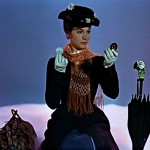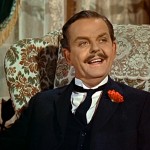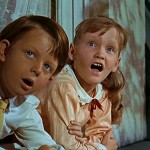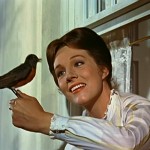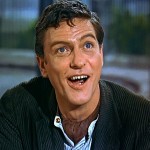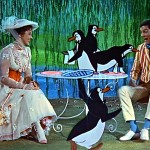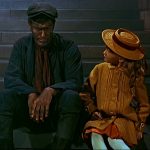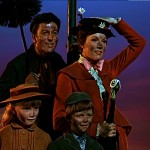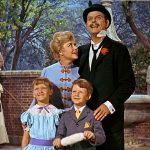
Mary Poppins – 1964
This is a film that I have seen many times. I know the songs, and I know the scenes. I know the actors, the costumes, the special effects, and the plot. I know which parts I like and which parts I don’t. The challenge with this review will be deciding what to leave out. Incidentally, the only thing I wish the movie would have left out was the song I Love To Laugh. I always have to roll my eyes during that scene. It is like uncomfortable, forced merriment, a standard Disney trait.
The film’s big star was Julie Andrews, playing the magical nanny, Mary Poppins. Opposite her is Dick Van Dyke, playing a common dustman named Bert. The story is centered on the Banks family. George and Winifred Banks, played by David Tomlinson and Glynis Johns, are the parents of Jane and Michael Banks, played by child actors Karen Dotrice and Matthew Garber. George is a jerk and a dismally unfeeling father. Winifred is a bubble-headed and subservient mother and wife. The children are undisciplined and stubborn with a penchant for running away from home.
The family is in a perpetual state of dysfunction. That is… until Mary Poppins arrives. Through the use of love, kindness, and a healthy dose of magic, she teaches the children to behave, and more importantly, she teaches the parents to pay attention to and love their kids. She is helped by Bert, a street-wise cockney who is full of sage advice.
And that’s the bare bones of the plot. The story is about the healing of the Banks family, but the fun is in the adventures the children have while learning their lessons about love, social awareness, and responsibility. The drama comes when George learns his lessons. Winifred doesn’t seem to learn much, as her character remains the same from beginning to end.
It is a sweet movie that is very obviously geared toward children. But every time I watch it, I can’t help but wonder about the relationship between Mary and Bert. They certainly have some kind of history. They seem to imply that the story they are playing out is one that has been lived through before. Bert is perfectly comfortable with Mary and her magical ways. The two speak to each other as old friends. But I want to know their history.
So I did a little research. Mary Poppins is based on a series of 8 children’s books written by P. L. Travers. In the books, Mary is much stricter and most of the time she is decidedly cross. But everyone loves her anyway because of her magic. And while I’m on the subject, I’d also like to know more about the nature of her magic. When viewed with a critical eye, she seems to be some sort of witch, almost like she belongs in the Harry Potter universe. She shows evidence of being telekinetic, telepathic, and empathic. She can converse with animals. And she carries magical objects like a carpet bag that holds more than it should be able to, or an umbrella handle that seems to be a sentient creature.
Her relationship with Bert seems to be one of deep platonic fondness. The character of Uncle Albert, played by Ed Wynn, who floats up to the ceiling whenever he laughs too much, is supposed to be Mary’s uncle. Clearly magic runs in their family. Bert, however, is just a friend of the family, and is specifically shown to have no magical powers.
Anyway, aside from all that, most of the film is just frothy and fun. The memorable songs were written by Richard M. Sherman and Robert B. Sherman. Great songs like A Spoonful of Sugar, Jolly Holiday, Supercalifragilisticexpialidocious, Step in Time, and Let’s go Fly a Kite are joyous and easy to sing along with. But the film was also smart by exploring a very serious and dramatic side. Other great songs like Stay Awake, Feed the Birds, and Chim Chim Cher-ee, have an almost melancholy quality that can be quite touching, the last one being about finding beauty in unexpected people and places.
The costumes, especially Mary’s, were beautiful and fanciful. I Particular liked the dresses she wore in the Jolly Holiday sequence and the rooftop sequence. The sets were wonderful and playful. Some of the sets were even animated. The entire Jolly Holiday section took place in a cartoon world, complete with singing barnyard animals and dancing penguins. The special effects were beautifully done, and pretty innovative for their time.
And lastly, I have to give a special shout-out to the film’s star, Julie Andrews. Not only did she look beautiful, but she had a golden voice that was absolutely flawless. She proved that she could dance as well as sing, and made it all look and sound effortless. Just like the character of Mary Poppins, Andrews was practically perfect in every way. Great performance, Julie!
